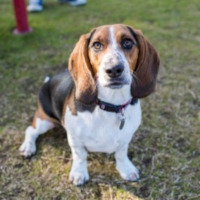Appearance of the Bagle Hound
|
| The Bagle Hound will often resemble a larger Beagle with longer ears, although its limbs are a little shorter and its body more compact. They have pleading eyes that are a deep shade of brown and a solid, square muzzle. Their lips are a little loose and drooping, although their fullness is less dramatic than that seen in the Basset Hound. Their necks are thick with moderate dewlap. They are medium-sized, with deep chests and fairly long bodies. At maturity, the Bagle Hound will measure 30 to 43 cm at the withers and weigh 15 to 25 kg. The Bagle Hound's short coat is silky to the touch and can be bicolored or tricolored, with orange, lemon, white, brown and black fur. Large patches and markings, as well as spots on the fur, may be present. |
Temperament of the Bagle Hound
|
| Although Basset Hounds and Beagles have traditionally done the same job, they actually have very different personalities. The Basset Hound is known for being relaxed and calm, while the Beagle can be mischievous and cheeky. The type of personality a Bagle Hound puppy will inherit is a bit of a gamble, and it can be difficult to predict the temperament of a hybrid breed. Most will have a temperament that falls somewhere in the middle, meaning they are more energetic than Basset Hounds but more relaxed and docile than Beagles. A dog that absolutely loves to be with people, the Bagle Hound is in its element when it's with family. As they would have been used to working with other dogs, they don't like to spend too much time alone and can be prone to separation anxiety. Not fussy at all, the Bagle Hound is happy in the company of anyone, which means animals too. These gregarious dogs like to be around other dogs, but can learn to love cats if socialized when they're young. |
Needs and activities of the Bagle Hound
|
| The Bagle Hound is a medium-energy, homogeneous hybrid, thanks to the blending of two parent breeds. Beagles, known for their mischievous and sometimes exuberant behavior, are great fun, but can be difficult to manage, while the Basset Hound is generally considered a lazy dog who walks and strolls with its long, floppy ears. Bagle Hound parents make this hybrid an excellent family dog, fond of children and friendly to strangers. Both parents like to be in contact with the family and are considered crazy, so they won't tolerate being left alone. The Bagle Hound may bark or become depressed if left without a companion all day. This hybrid will do well with another dog, or even the cat, for company. Basset Hounds and Beagles are intelligent and sometimes a little stubborn dogs. Your Bagle Hound may therefore inherit a certain stubbornness, making him a little difficult to train. Many owners resort to food-based reward methods, but be careful as this hybrid tends to put on weight. |
Maintenance of the Bagle Hound
|
| The Bagle Hound is a cross between two dogs known to shed moderately, although their coats are short. A brush or mitt will help remove dead or loose hair from the coat and promote new hair growth. The Bagle Hound doesn't need daily brushing, but once a week will help maintain its coat and smell. The Bagle Hound can develop a doggy smell, but you can avoid this with frequent brushing. Cleaning your Bagle Hound will help evenly distribute the natural oils produced by its skin. Occasional bathing is fine, but frequent bathing is not recommended, as it could strip away the natural oils and cause dermatitis. Basset Hounds are notorious for drooling, and your Bagle Hound, although much tighter, can sometimes drool more than a Beagle. Drooling can be a sign of exhaustion, thirst or hunger. The Bagle Hound is more likely to develop ear infections because of its large, long ears. Check and remove dust, debris or wax from your Bagle Hound's ears as you groom him to help keep him healthy. |









 English (United Kingdom)
English (United Kingdom)